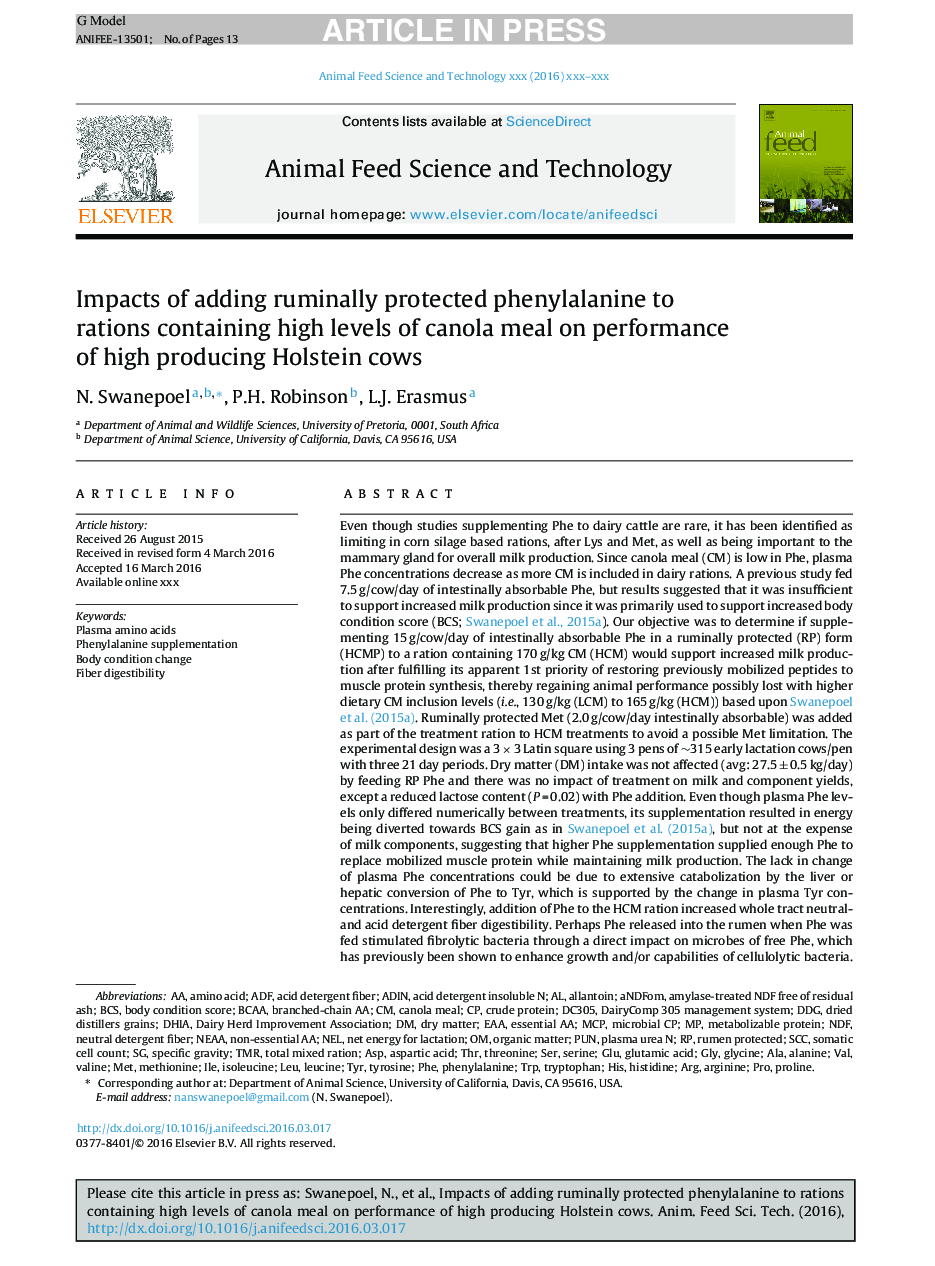| Article ID | Journal | Published Year | Pages | File Type |
|---|---|---|---|---|
| 8491238 | Animal Feed Science and Technology | 2016 | 13 Pages |
Abstract
Even though studies supplementing Phe to dairy cattle are rare, it has been identified as limiting in corn silage based rations, after Lys and Met, as well as being important to the mammary gland for overall milk production. Since canola meal (CM) is low in Phe, plasma Phe concentrations decrease as more CM is included in dairy rations. A previous study fed 7.5 g/cow/day of intestinally absorbable Phe, but results suggested that it was insufficient to support increased milk production since it was primarily used to support increased body condition score (BCS; Swanepoel et al., 2015a). Our objective was to determine if supplementing 15 g/cow/day of intestinally absorbable Phe in a ruminally protected (RP) form (HCMP) to a ration containing 170 g/kg CM (HCM) would support increased milk production after fulfilling its apparent 1st priority of restoring previously mobilized peptides to muscle protein synthesis, thereby regaining animal performance possibly lost with higher dietary CM inclusion levels (i.e., 130 g/kg (LCM) to 165 g/kg (HCM)) based upon Swanepoel et al. (2015a). Ruminally protected Met (2.0 g/cow/day intestinally absorbable) was added as part of the treatment ration to HCM treatments to avoid a possible Met limitation. The experimental design was a 3 Ã 3 Latin square using 3 pens of â¼315 early lactation cows/pen with three 21 day periods. Dry matter (DM) intake was not affected (avg: 27.5 ± 0.5 kg/day) by feeding RP Phe and there was no impact of treatment on milk and component yields, except a reduced lactose content (P = 0.02) with Phe addition. Even though plasma Phe levels only differed numerically between treatments, its supplementation resulted in energy being diverted towards BCS gain as in Swanepoel et al. (2015a), but not at the expense of milk components, suggesting that higher Phe supplementation supplied enough Phe to replace mobilized muscle protein while maintaining milk production. The lack in change of plasma Phe concentrations could be due to extensive catabolization by the liver or hepatic conversion of Phe to Tyr, which is supported by the change in plasma Tyr concentrations. Interestingly, addition of Phe to the HCM ration increased whole tract neutral- and acid detergent fiber digestibility. Perhaps Phe released into the rumen when Phe was fed stimulated fibrolytic bacteria through a direct impact on microbes of free Phe, which has previously been shown to enhance growth and/or capabilities of cellulolytic bacteria. Total net energy output decreased with HCM feeding, but was restored to the level of the LCM ration for the HCMP treatment suggesting that further investigation to determine if an even higher Phe supplementation level may have additional benefits on milk production may have merit.
Keywords
SCCPHEASPALATMRLEUDairy Herd Improvement AssociationTrpRumen protectedEAAMCPTHRmicrobial CPNEAANDFDDGADFaNDFomADINArginineAspartic acidalanineAllantoinamino acidArgPlasma amino acidsglutamic acidacid detergent fibernet energy for lactationplasma urea NisoleucineIleSERBCAAthreonineTryptophanSomatic cell countTyrTyrosineHISDried distillers grainsNELBCsbranched-chain AAvalSerineessential AACanola mealPhenylalanineneutral detergent fiberLeucineorganic matterdry matterMethionineMETacid detergent insoluble NPROBody condition scoreFiber digestibilityPunhistidineValineSpecific gravitycrude proteinmetabolizable proteinProlinetotal mixed rationGluGlyGlycine
Related Topics
Life Sciences
Agricultural and Biological Sciences
Animal Science and Zoology
Authors
N. Swanepoel, P.H. Robinson, L.J. Erasmus,
